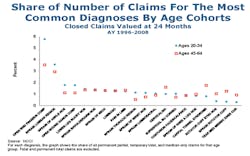The work force is getting older. People are retiring later in life than ever before. This trend has been a major concern for those in the health and safety field because the common knowledge has been that older workers are more prone to suffer very expensive injuries.
However, new research from the National Council on Compensation Insurance (NCCI) has cast doubt on this conventional wisdom, or at the very least, potentially changed the definition of "older workers." NCCI studied different age groups and the rate at which they get injured. They found younger workers (under 35) had substantially more cuts on their fingers and older workers (over 35) suffer more cases of carpal tunnel and more neck injuries, although the numbers are startlingly similar.
So, that quiets the argument about the aging work force having more injuries, but what about cost? The research shows that there is a substantial cost difference between the injuries suffered by younger and older workers, but the split isn't necessarily where you might expect it. Workers between the ages of 20-24 create much lower costs and fewer lost-time days, but once workers reach 35, the costs of their injuries are very similar to older workers.
What does this all mean? To start with, it now largely redefines an "older worker" as someone who grew up listening to disco instead of Elvis. This means that someone over 35 – not just someone belonging to the traditional "over 65" group – now is being classified as an "older" worker. It also should prompt businesses to focus on the things that can reduce injury costs for everyone.
Early Prevention
Injury prevention for employees should begin before they even become employees, during the hiring process. Start with a written functional description for the position that is open. Once that is complete, it is critical that the candidate you select be given a conditional offer of employment. This document is a bona fide job offer with the caveat that you can withdraw the offer if he is physically or mentally unable to do the job with reasonable accommodation.
Once this is complete, have the candidate go to the doctor and complete a post-offer, pre-placement medical questionnaire. Having this completed allows a physician to ask questions relevant to the job and to let the employer know whether or not the candidate is fit for the job. If he is fit, it's time to get started. If not, you'll have to find another suitable candidate.
Once an employee is on the job, it is critical that he is mindful of how he is performing job tasks. Employees who feel rushed are more likely to set safety aside in the name of meeting a deadline, and those decisions result in injuries that could have been prevented.
When you take all these steps and have a work force that is fit for work and doing the job safely, then the focus turns to what happens when an accident does happen and an employee is injured.
When Injuries Occur
Employees must know before they get hurt who they should talk to when they suffer an injury. Immediate injury reporting is a key to keeping injury costs as low as possible. Studies have shown that the costs of an injury go up when there is a delay in reporting. Make it your policy that any employee injury is reported before the end of the shift.
Once the injury is reported, getting the proper treatment is key. Your company should have a relationship with an occupational medical provider in your area. You can find board-certified occupational doctors online at http://www.acoem.org. Even if there isn't an occupational medicine specialist in your town, you can develop a relationship with a physician and send your injured employees to that doctor.
The goal of having a relationship with a workers' compensation specialist medical provider is to ensure that the doctor knows your business and the physical demands that your employees are under. They also should have a good knowledge of the transitional work that you have available. When a doctor knows that you will accept an employee back to work on transitional duty, they are far more likely to send them back to work rather than send them home to sit on the couch and watch infomercials for attorneys at 1-800-SUE-THEM.
When an employee is at work, he is less likely to hire an attorney and more likely to work hard to get back to a full-duty position. This process not only gets employees back to work more quickly, it also reduces the amount of money that the insurance company spends on employee injuries, reducing your experience modification factor and, therefore, your workers' compensation insurance costs.
With the work force getting older, we need to be mindful of accommodations that older workers may need today that they didn't need before. However, this new research from NCCI should sharpen an employer's focus on what can drive down injury rates and costs, like hiring the right people and training them to do their jobs safely, and when accidents do happen, making sure they immediately are reported and treated by a skilled physician who will send them back to work rather than send them home.
If employers follow those steps, having older, experienced workers on the payroll can be a great asset rather than a potential liability.
Kevin Ring is the director of community growth for the Institute of WorkComp Professionals, which trains insurance agents to help employers reduce workers' compensation expenses. A licensed property and casualty insurance agent, he is the co-developer of a new workers' compensation software suite that will help insurance professionals work with employers. He can be contacted at 828-274-0959 or at [email protected].
About the Author
Kevin Ring
Kevin Ring is the lead workers’ compensation analyst for the Institute of WorkComp Professionals, which trains, certifies and mentors insurance agents to help employers reduce workers’ compensation expenses. A licensed property and casualty insurance agent, he is the co-developer of a workers’ comp software suite that helps insurance professionals manage their clients workers’ compensation programs.

